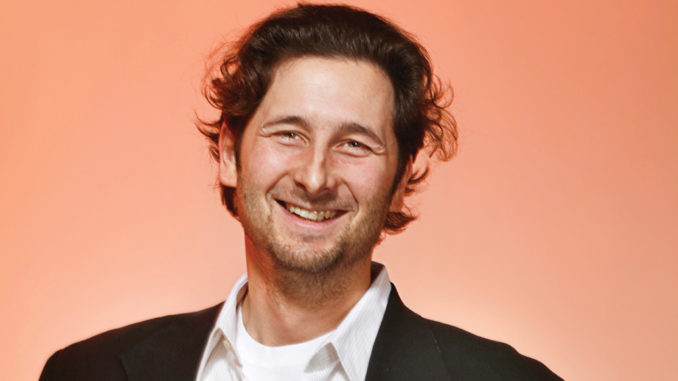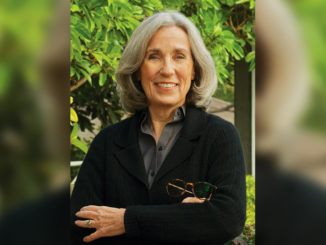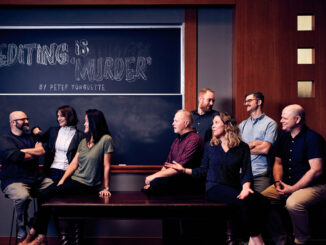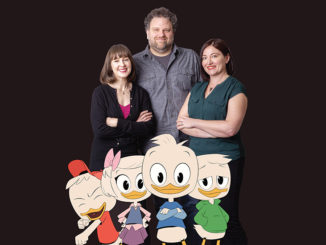
by Rob Feld • portrait by Kfir Ziv
The son of noted playwright Arthur L. Kopit, Alex Kopit is an assistant editor with a philosophy designed to aid the creative process. He was an assistant on Jarhead and served as first assistant to editor Jeff Buchanan on Michel Gondry’s Be Kind Rewind. He has also edited a number of indie films and shorts along the way. Kopit is currently working with Buchanan on Gondry’s “Interior Design.” CineMontage asked him about his background and his approach to assistant editing.
CineMontage: Your upbringing seems to have given you an interesting perspective on your job.
Alex Kopit: I was very lucky to grow up in a family of writers. My mom is a journalist who interviewed other writers, including Harold Pinter and Joan Didion. My dad was always in development on plays and musicals, with composers constantly coming over to work things out on the piano. So, as a kid, I fell in love with story. We were always talking about it, working it out. My parents would ask for my opinions and gave me a lot of encouragement. From that, I also developed a love of the process of the artist. My mom would cover the whole second floor of the house with note cards when she was preparing a piece. She would show me how shuffling the cards was what shaped the narrative of the story. My dad worked in very similar ways, with boards and outlines everywhere.
I really believe that as an artist and filmmaker––certainly as an assistant editor––we’re always searching for systems and workflows to manage the enormous amounts of media, data and material that we have to process; to do it in a way that doesn’t overwhelm us but will benefit our likelihood of getting inspiration and nonlinear thought. You have to be both an engineer and a musical freethinker.
CM: How do you reconcile that duality?
AK: Recognizing this duality in the artist’s process is a big part of what draws me to it. Movies were what I always really loved, and when I studied film at Dartmouth, we had 24-hour access to the editing room flatbeds. I loved the post process; you could put stories together the way my parents did, but also work with your hands. I fell in love with bringing a little brawn and sweat, and cutting with scissors and taping with tape.
CM: How did you become an assistant editor?
AK: I got into assisting after working on an indie feature called The Tollbooth. David Shire was doing the score. He scored The Conversation, which was a movie that really affected me as a kid. I kept asking him about it, and when The Tollbooth finished, he put me in touch with Walter Murch in California. I flew out a week later to meet with him and assistant editor Sean Cullen. He was working on Jarhead and I ended up staying in LA for a couple of months––and then came back to New York as an assistant on the film!
“We need to create the system that will lead to the story insight, the narrative inspiration.” – Alex Kopit
CM: That must have been quite a change of pace from the super-low-budget indies you were teaching yourself on.
AK: It was a lot more difficult––but also much easier. It seemed there was one person for every job, so you only had to focus on one thing at a time, which was amazing to me. But, because your job was just that one thing, you’d better get it right the first time. I was in awe of Walter’s process, specifically the logical systems that he employed to find story. Something I feel I understand is logically approaching something that is illogical. How can I deductively process and grind a project forward, while leaving enough space for the intangible, so that inspiration will come through? How do you plan to have as many unplanned moments as you could possibly have?
CM: So how does one?
AK: Walter set up his scene boards with a specific scene description on each note card, and on different colored cards relating to sequence; the note cards would also have a different shape according to their relative purpose in the movie. If the scene was a turning point for a character, for example, that card might literally be turned sideways. He told me he really liked doing it himself––sitting down with tape, glue, note cards and scissors, and writing them and thinking about the shape. That helps him initially think about the way the story is going to be, without being on the computer or editing system. He uses picture boards with at least one image for each setup. Placed all over the walls, these boards surround the editing suite and it looks amazing. He told me they whisper to him. I understood what he means: the juxtaposition of, say, Scene 2 picture board with Scene 12 picture board––just because they’re next to each other in the editing suite––might lead to the idea of an intercut sequence. There are all sorts of ways that ideas can bounce around. We made similar boards for Be Kind Rewind.
CM: What was your first task on Be Kind?
AK: Producer Ann Ruark called to see if I could talk to her about a Final Cut workflow for Be Kind. I met with the crew and loved Jeff instantly; he was easy-going, very insightful; and we got along fantastically. So I signed on to be his assistant and started designing the equipment for the job. We bought the equipment and Apple donated a bunch. We put together everything we’d need, and designed the workflow based on the equipment.
CM: What equipment did you use?
AK: We had three main Final Cut systems, a Facilis 24 terabyte shared system, numerous laptops hooked up through an Ethernet network, and a separate server for FileMaker. I do a lot of work in FileMaker. A ton of what we did in Be Kind Rewind––and now on Michel’s new movie––is about taking all the stuff into Cinema Tools from Final Cut, making sure the info is correct, and importing that into FileMaker. Because we’re working with Final Cut and QuickTime, even when we’re in HD, we can link to and view all the QuickTime images and we can listen to the audio with File Maker. Though we couldn’t see the moving images on our remote systems and laptops, we could still access all our metadata and Final Cut info. So we were able to have a great many more systems than just the main three—probably six running, on average.
“[Walter Murch] uses picture boards with at least one image for each setup. Placed all over the walls… He told me they whisper to him. I understood what he means: the juxtaposition of, say, Scene 2 picture board with Scene 12 picture board––might lead to the idea of an intercut sequence.” – Alex Kopit
CM: It sounds like it was a lot of effort.
AK: It was a tough workflow that we sent to the labs; tons and tons of film, very very fast. I think we had two or three rooms running simultaneously, multiple shifts, so they were overwhelmed. There was also a lot of additional work for us to do before we could release the footage to Jeff; keycode, camera rolls, shot names––everything had to be checked.
We were using a British slating system on Be Kind, which was great, especially working on a movie where we’re not sure which shots are going to end up where, or we’ve got one setup that’s going to be used in five different scenes; to call it “Scene 12” wouldn’t make sense. We would label everything by setup, then scene, then camera, then take. We went through everything in the dailies process to make sure that it was all correct from the lab. That took a very, very long time. But, once we had it all correct, we had this system where you could basically hit “Go,” and all the metadata and media were sent to everywhere else; it breaks down into your scenes, your multiple cameras, sound rolls, everything––and you can access it in your FileMaker log by searching for any of that information. What happened on Day 12? Everything’s there.
Considering how large the scope of the project was, we really had a small team. But we were able to get it done because we had set up a system during the initial dailies where we could all be sharing it simultaneously.
CM: Did you do this because of the specific requirements of Be Kind?
AK: We were going to get hit with a lot of stuff and had to spit it back out very fast. We shot multiple formats on set: 35 anamorphic, plus the VHS with no time code for the sweded stuff. They had to be treated very differently. We would transfer the VHS to Digibeta to give it time code, but because of our very short turnaround requirements, we edited some sweded movies straight from the VHS, as they were shot. We were also editing HD for the movie. We kept two separate projects, but used a lot of the sound files from the film for the videos, so we had to be able to cross-reference all those things––which was easy for us to do with our FileMaker setup.
The number one priority for this movie was to have everything organized so we could keep track of it, but also in a way that we could juxtapose any elements for Jeff and Michel. If they said, “Let’s see Day 12, but with all the sound that we recorded yesterday,” we could do that in about 30 seconds. Because we were on set, the time we had with Michel was very limited and we had to get there very quickly.
“I really believe that as an artist and filmmaker––certainly as an assistant editor––we’re always searching for systems and workflows to manage the enormous amounts of media, data and material that we have to process; to do it in a way that doesn’t overwhelm us but will benefit our likelihood of getting inspiration and nonlinear thought.” – Alex Kopit
CM: Tell me about the sweded movies.
AK: That was an enormous part of our time, coupled with the fact that we wanted to move quickly on the first assembly of the 35mm footage to make sure we had the coverage we needed. The coolest thing about our workflow was that we were able to track an enormous amount of material––but also track it in its native formats so that we knew where its highest resolution formats were and had access to them right away, so we could do our own on-lines. We surrounded ourselves with all the footage and elements, so that walking into our editorial, you would see all the pictures and hear all the sounds. I think this was very nice for Jeff and Michel.
CM: What was it like working with Michel?
AK: Michel seems to enjoy working in a kinetic environment, where ideas are bouncing all over the place. Working with him, you really get the sense that ideas can come from anywhere and that anyone’s contribution may make it onto the big screen. A big part of my job was to keep what was just shot very present. So when walking into editorial, you’d find not just enormous lists and databases, but actually a bunch of images, pictures and sounds that would lead to creative elements. It was a wonderful job to work on. It was also great to have to anticipate the unknown requirements––and being able to put that into the cut right away.
CM: Is that the duality in the artist’s process again?
AK: The thing about the artist’s process, working as a filmmaker and especially in editorial, is that we’re in a constant battle to design new systems and workflows that can handle or manage enormous amounts of data, and then process and redistribute. But, more importantly, I feel we need to create the system that will lead to the story insight, the narrative inspiration. In post, the logical step-by-step system building and the nonlinear stream of consciousness thinking are two sides of the same coin, and that’s really the larger goal of everything I do.






